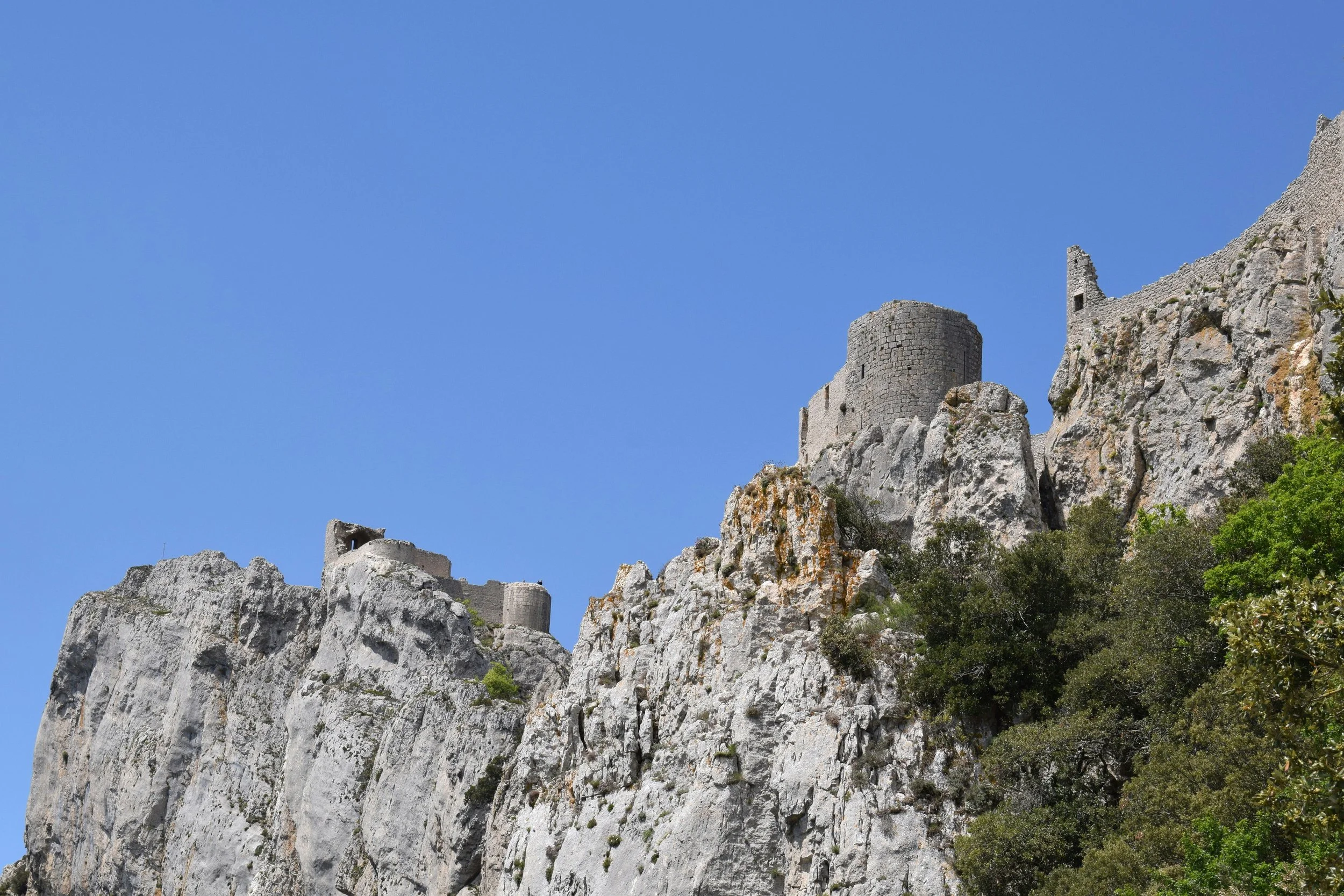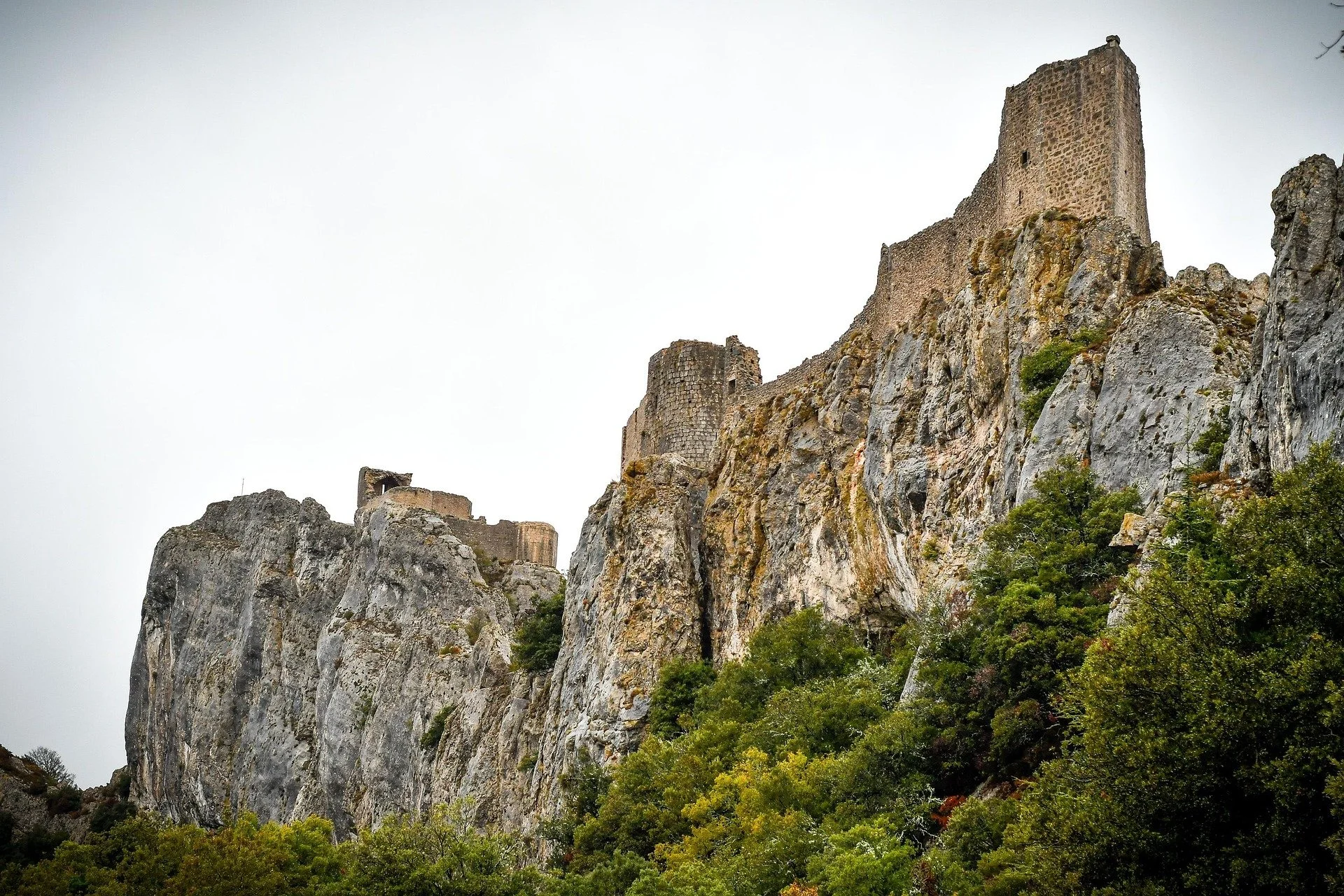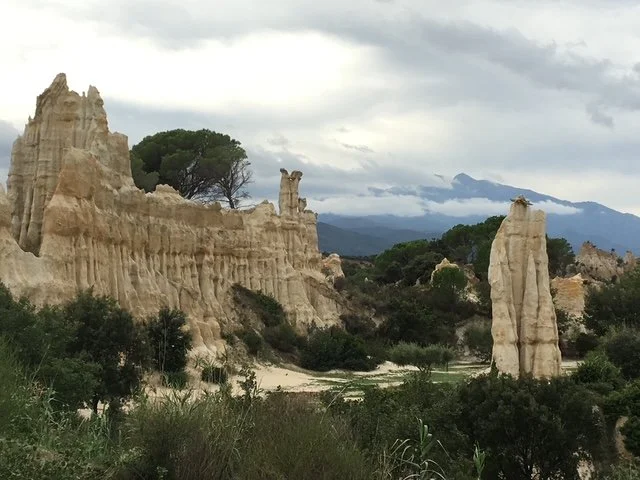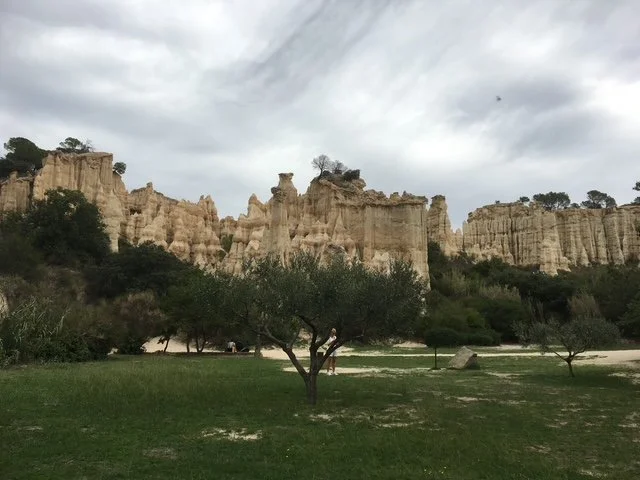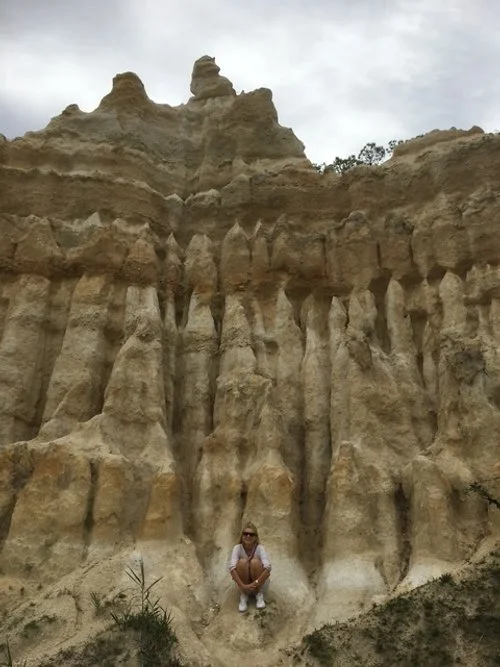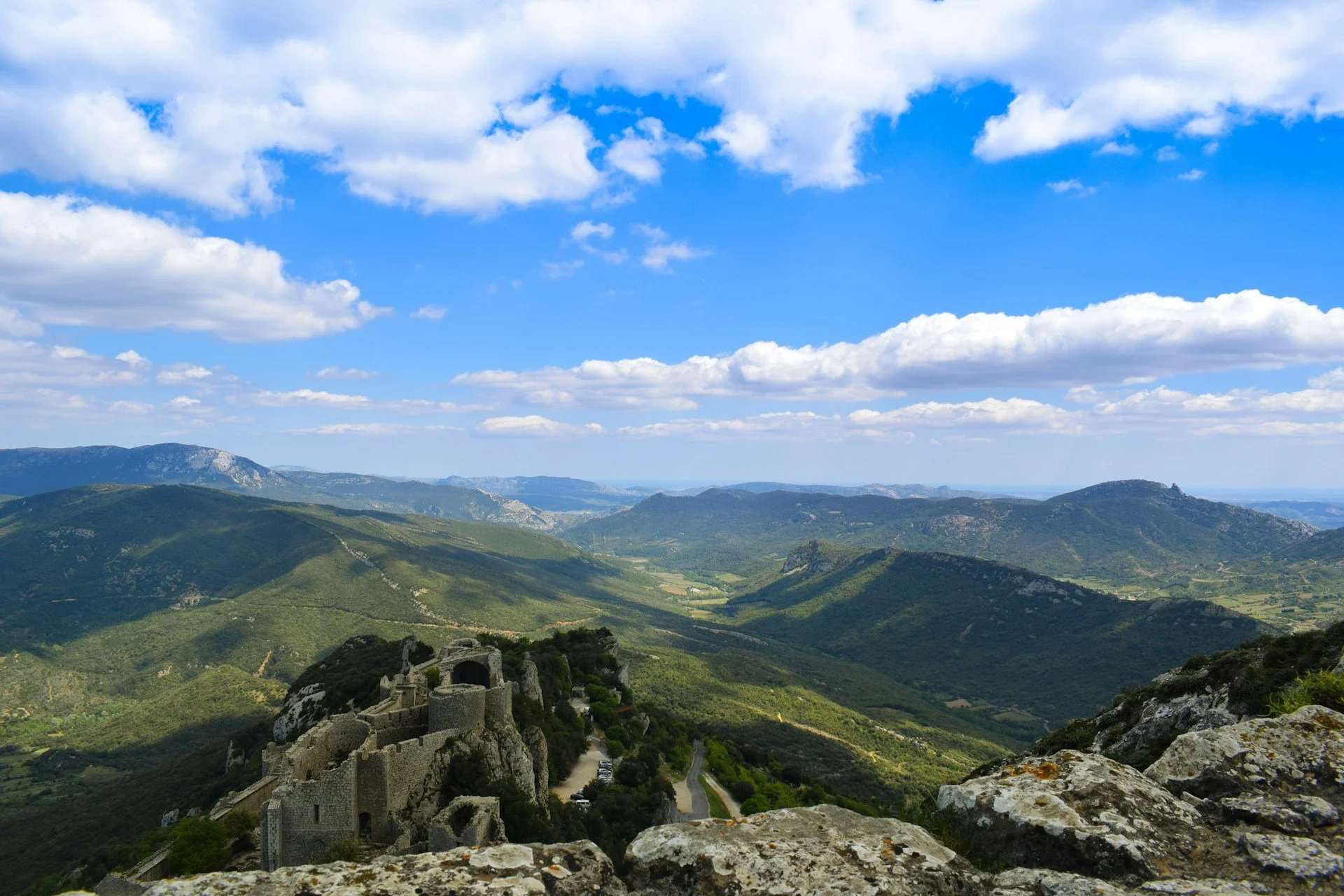
Things to Do near Perpignan
Villefranche-de-Conflent & Les Grottes des Canalettes
There’s something witchy and Harry Potter’s Diagon Alley about Villefranche-de-Conflent…Tucked in a narrow valley where the Tet and Cady rivers meet, Villefranche-de-Conflent is a step back in time and a perfectly preserved medieval walled town that feels almost like a film set.
Founded in 1092 as a strategic garrison town, Villefranche’s defensive importance is evident the moment you see its walls. High stone ramparts encircle the village, punctuated by watchtowers and gates, all later strengthened by the famous military engineer Vauban in the 17th century.
Walking through the main gate feels like passing through a portal to the Middle Ages – cobbled streets, quaint stone houses, and pink marble facades from local quarries give the town a unique character. Above the village looms Fort Libéria, a separate fortress built in 1861 perched on a steep hill overlooking the town. Which you can reach via footpath or an astounding underground staircase of 734 steps cut into the rock from Villefranche. There’s also a vehicle shuttle for those who prefer not to hike.
Just outside town are LesGrottes des Canalettes, an incredible cave system with 500 metres of impressive stalactites and stalagmites that was discovered in the 1950s. I’ve been quite a few times. It’s really worth seeing and rather beautiful., Much of the trail is suitable for those with reduced mobility, but the deeper chambers do involve some stairs and uneven ground. The cave is open from April to November and entry is €12 for adults and €6 for children aged 5–12.
The Yellow Train
Starting at Villefranche-de-Conflent, the Yellow Train, nicknamed “Le Canari” for its bright canary-yellow carriages, is a historic feat of engineering and an unforgettable travel experience. This little meter-gauge railway has been operating for over a century, climbing from the lower valleys up into the Pyrénéan highlands along a 63 km route eventually reaching Latour-de-Carol (near 1,232 m at the Spanish border).
The train traverses some of the most dramatic landscapes in the region. It’s not just a mode of transport – it’s a journey through the mountains, often clinging to cliffs, crossing deep gorges on spindly bridges and offering panoramic views at every turn. To achieve this, the route tunnels through 19 mountainsides and crosses about 40 bridges, including two particularly famous ones. The graceful stone Pont Séjourné viaduct arches over a valley at 236 m long, while the Pont Gisclard is a rare suspension bridge carrying railway tracks – the only one of its kind still in use in France.
Most visitors take the Yellow Train as a day trip or half-day excursion. You can do a round-trip from Villefranche to, say, Mont-Louis or Font-Romeu and back. Mont-Louis (a fortified town and UNESCO site) is about halfway and makes a good stop before returning.
Frenzy Waterpark
Frenzy Waterpark, 20 minutes from Perpignan in Torreilles, is one of the largest in France with over 20,000m2 of waterpark! This expansive water park (around 20,000 m² of aquatic space).
The park features a giant inflatable obstacle course floating on a tropical pool as well as multiple waterslides and bodyboarding tracks for adrenaline lovers. The water jump ramp involves you taking a running slide down and then getting launched into the air before plunging into a deep pool!
Palms and thatched umbrellas give it a beachy vibe and a heated lagoon pool lets you laze in warm water when you need a break from the high-octane activities. Open from June to September.
Château de Peyrepertuse
About an hour from Perpignan is the famed Château de Peyrepertuse, perched on a narrow limestone ridge about 800 m high, the castle stretches an astonishing 300 m along the ridge and has stunning views. To get up there requires a walk up steep footpath zigzags up through shrubland for about 20 minutes. Once inside, you’ll find that Peyrepertuse is not just one castle but effectively three castles in one, built at different levels of the ridge.
The lowest enclosure were living quarters and a small chapel, now mostly crumbled stone outlines. Above that was the main keep and courtyard. Then, perched even higher on a pinnacle is Sant Jordi chapel, built in 1250 on the orders of King Louis IX. Historically, Peyrepertuse is entwined with the saga of the Cathars. During the Albigensian Crusade in the early 13th century, this castle served as a refuge for Cathar knights. However, unlike most other Cathar castles that fell in bloody sieges, Peyrepertuse avoided destruction when it surrendered in 1240 and was incorporated into the French royal domain.
Château de Castelnou
Twenty five minutes from Perpignan, Castelnou Castle is a commanding medieval fortress perched on a rocky outcrop above the picturesque artists village of Castelnou and served as seat of the Castelnou Family from the 10th until 14th century. I’ve visited Castelnou many times over the years – as much for the village as the castle – and love the intimacy of it and its setting in the foothills of the Pyrenees. History-wise, it’s had its fair share of battles and sieges, seized by James II of Majorca in 1286, contested again in the 15th century and then largely abandoned by the 17th century.
Visiting today, you’ll find the main halls and vaulted chambers of the castle opened to the public with exhibitions of medieval armour, weapons and exhibitions that tell the story of Castelnou and Roussillon’s history. The panorama at the top is worth the climb with sweeping view over the red-tiled roofs of Castelnou village and the distant Pyrenean peaks.
I’ve often complained that French castles are often empty of exhibits and can be rather dull and soulless, but I’m pleased to report that Castelnou is bucking the trend with lots of props and exhibitions to capture the imagination! I also like the village as lots of artist actually live in the village and sell their pieces along the walk up from the castle.
I also found a great restaurant called L’Hostal, which serves delicious barbecued meats, with good service, and with beautiful views. If you can’t find it, just follow your nose and follow the smell of barbecued meat!
The château is generally open from spring through early autumn, with extended hours in summer—often 10:00–19:00 in July‑August and shorter hours (around 11:00–17:00) in off-seasons. Entry is €6.50 for adults.
Rivesaltes Detention Camp Memorial
I think everyone should visit the Camp de Rivesaltes Memorial at least once in their life to serve as a memory and reminder of the tragic chapters of the 20th century including the Spanish Civil War and the Second World War. Located on a windswept plain near Rivesaltes, just north of Perpignan, this site was once an internment camp that witnessed multiple tragic chapters of 20th-century history.
Camp Joffre, as it was originally known, opened in 1938 as a French military camp. Then, from 1938, during the Spanish Civil War, Rivesaltes became a major refugee camp for Republican Spaniards fleeing Franco’s regime. Thousands of men, women, and children who had crossed the Pyrenees from Spain ended up behind the barbed wire here.
Then came World War II and the Vichy regime and the camp turned into an internment and transit camp for “undesirables” including Jewish refugees and Roma (Gypsies) rounded up by Vichy France. Tragically, over 2,000 Jews were deported east to extermination camps and died. The exhibitions at the memorial include heart-wrenching personal accounts from this period – letters, photographs and artifacts that bear witness to the prisoners’ experiences.
After 1945, the camp’s use shifted yet again: it briefly held Axis prisoners of war and French collaborators, and in the 1950s–60s it was used to house Harkis (Algerian Muslims who had fought for France in the Algerian War) and their families, who often lived in grim conditions. Incredibly, part of the site even served as a detention centre for undocumented migrants up until 2007, when the camp finally closed for good.
Walking the grounds, you see the crumbling concrete foundations of barracks and fencing posts stretching over a vast area – a stark reminder of how large the camp was (it covered 612 hectares at its height).
The Memorial Museum, which opened in 2015, is itself an architectural statement. Designed by architect Rudy Ricciotti, it’s a long, low semi-buried monolith of reddish concrete that almost blends into the soil. This intentional design means the building doesn’t dominate the landscape or overshadow the ruins of the camp; it feels hidden and sombre, much like the stories it contains.
A visit here is emotionally heavy but essential to witness. One section that stands out is the outdoor path through “Block F”, one of the former housing sectors of the camp. As you walk the same ground where internees once queued for rations or roll-call, the museum provides context about daily life in the camp. While the subject matter is difficult, this site is extremely relevant – it ties together threads from World War II, colonial history and contemporary issues of displacement. As one display aptly notes, Rivesaltes is unique because “nowhere else does one site’s history encompass the entirety of those conflicts and peoples”. Indeed, it’s been called a mirror of Europe’s 20th century.
Opening times: From 1 April to 31 October, from 10 am to 6 pm, every day. From 1 November to 31 March, from 10 am to 6 pm, Sunday to Friday. Closed on: 1 January, 1 May, 1 November and 25 December.
Céret Modern Art Museum
The small picturesque town of Céret, 30 minutes from Perpignan, boasts a Modern Art Museum that would be the pride of a city ten times its size with a collection that reads like a Who’s Who of 20th-century art: Picasso, Matisse, Chagall, Braque, Soutine, Miró and many more.
How did such a little town acquire such treasures? The answer lies in Céret’s extraordinary story as an artists’ haven in the 1910s and 20s, a place where leading avant-garde artists gathered for inspiration. The museum itself was founded in 1950 by two respected artists, Pierre Brune and Frank Burty Haviland, with support from Pablo Picasso and Henri Matisse.
When you visit, the first thing to appreciate is that Picasso himself donated 57 works to this museum and it holds 78 pieces by Picasso in total, including sketches, ceramics and paintings that span his many styles. The museum also has sculptures by the famous sculptor Maillol, works by Chagall (who hid in Céret during the Second World War) and bold abstracts by Joan Miró and Antoni Tàpies.
The town of Céret itself is absolutely charming and worth a visit in itself with cobbled streets shaded by plane trees, lively cafés,and an old stone bridge (Pont du Diable), the Devil’s Bridge, that painters loved to capture on canvas. Ideally, I recommend you come on a Saturday, so you can wander through the famous Saturday market then followed by the art museum and nice lunch makes for a delightful day out.
Oniria Aquarium, Canet-en-Roussillon
Just a 15 minute drive from Perpignan is the world class Oniria Aquarium. Opened in 2021, it boasts 83 tanks of all sizes filled with an astonishing variety of life with over 600 species and about 3,500 fish in total. I’m biased as I love scuba diving and sealife, so I just love Oniria Aquarium. You start in mountain waters of the Pyrenees lakes, then descend through rivers, mangrove swamps with piranha fish, coral reefs and eventually the open ocean filled with large sharks.
Some tips on visiting: buy an online ticket (and dodge the long queue during the summer) and come when it opens and you’ll have much more space to enjoy the sealife. Opening times: Oniria Aquarium is open every single days of the year!
Réserve Africaine de Sigean
Ever fancied going on safari without flying to Africa? At Réserve Africaine de Sigean, about an hour from Perpignan, this sprawling wildlife reserve is part zoo an part nature park where hundreds of animals roam in expansive habitats reminiscent of the African savannah, bush, and wetlands. Covering over 300 hectares of land, Sigean is home to around 3,800 animals of 160 species. Visiting is a full-day adventure: you’ll drive your own car through several large enclosures for the “safari” portion then explore the rest on foot along landscaped trails and lakes.
One moment you’re driving past a huge herd of zebras, grazing antelopes and ostriches, the next you might be inches away from a towering giraffe that’s decided to amble across the track. In another sector, you’ll navigate slowly through the territory of the white rhinoceros lumbering in the scrub. Finally, you reach the lions’ enclosure where you’ll often see them lounging under a tree or even right on the road.
After the car safari, you park and continue the adventure on foot with large aviaries full of storks, flamingos, islands where chimpanzees clamber in the trees, pens for elephants and giraffes, which you can see from raised platforms.
A few tips: I suggest you arrive early when it opens, as animals tend to be more active in morning (and you beat the crowds). In summer, it can get quite hot by afternoon, so carry water and wear a hat for the walking parts. Also, don’t forget your binoculars for spotting animals in the distance, especially in the lion and bear reserves where they might be under shade farther from the track. Opening times: Sigean is open every day all year round.
Forteresse de Salses
Squat, massive and immensely fortified, Forteresse de Salses, 20 minutes from Perpignan, is a 15th-century stronghold that guarded the historic frontier between France and Spain until the mid-17th century. Today, it stands perfectly preserved, looking almost as intimidating as when the Spanish Kingdom of Aragon completed it in 1503. From the outside, Salses fortress is all about brute strength. It’s built low to the ground, with a squat profile meant to better resist cannon fire.
The outer walls are up to 10 metres thick in places, and they’re further protected by a deep dry moat hewn into the bedrock. Inside, there’s a large central courtyard and multiple rings of defences and, in its heyday, it could shelter 1,500 soldiers and 300 horses within its barracks and stables, plus enough supplies to withstand a long siege.
The fortress often changed hands. When French forces attacked in 1503, Salses’ thick walls absorbed the cannon blasts and proved nearly impregnable. But, the French captured it in 1639, then the Spanish retook it in 1640 and the French seized it back again in 1642. Finally, with the Treaty of the Pyrenees in 1659, the border moved south to the Pyrenees mountains and Salses lost its strategic importance.
Did I enjoy visiting the Salses Fortress? Well, it’s got a very interesting history and it’s in very good condition, but it suffers from having very little exhibits or much life to it. Like the Palace of the Kings of Majorca, it suffers from being administered by the government and so is quite a sterile affair. Once again, I wish they injected some theatre, sights, smells, props and exhibits. A lot of the time it’s just a lot of walking around empty rooms, so it represents another missed opportunity and I think it could become a much more popular attraction as a result.
Les Orgues d’Ille-sur-Têt
30 minutes from Perpignan, near the town of Ille-sur-Têt, lies a surreal natural wonder called the “Organ Pipes” of Ille. This protected site features bizarre towering rock formations carved by erosion into shapes resembling organ pipe columns and fairy chimneys. Formed from sand and clay over millions of years, the tallest reach around 15 metres high. Wandering among these otherworldly pillars is like stepping onto a sci-fi film set or a moonscape.
Just note that the formations are fragile and eventually nature will erode them away, so see them while you can! My tip: early morning or late afternoon light makes their colours and textures especially beautiful.



